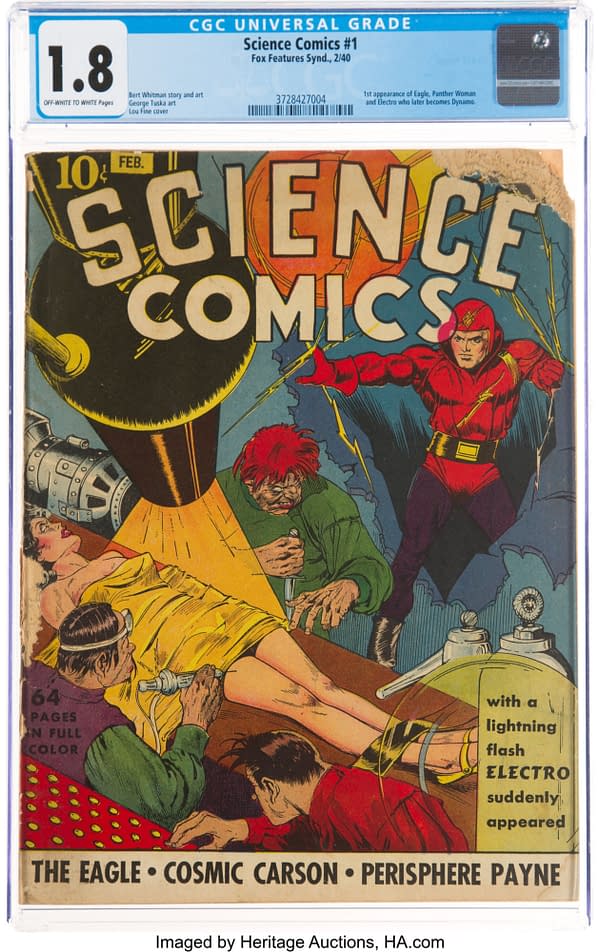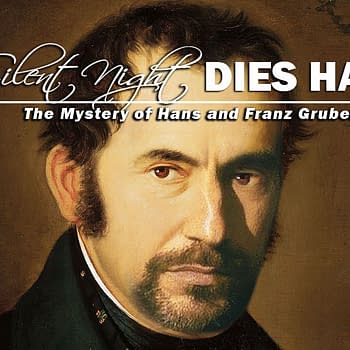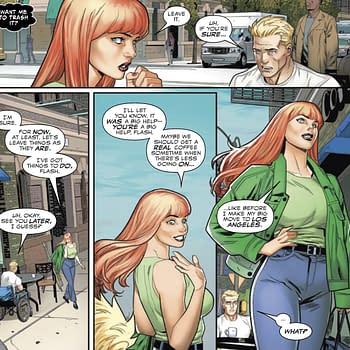Posted in: Comics, Heritage Sponsored, Vintage Paper | Tagged: fox features syndicate, Science Comics, victor fox
Dr. Doom and the Quantum Realm in Fox's Science Comics #1, at Auction
Victor Fox was not the kind of man to let a little legal scuffle slow him down. Despite fighting a then ongoing battle with DC Comics since the moment Wonder Comics #1 was released (Wonder Comics #1 has a copyright date of March 17, 1939, DC v Bruns was filed on March 16), Fox expanded his comics empire rapidly throughout the rest of that year. By the month that Science Comics #1 was released in January 1940, Fox had launched five ongoing comic book series. Fox's early releases are highly sought after by collectors due to a combination of their high-quality content and their relative rarity vs Marvel and DC Comics releases of the same era. There's a few stand-out examples in Science Comics #1 CGC GD- 1.8, Science Comics #8 CBCS GD/VG 3.0, and Science Comics #7 CGC VG 4.0 in today's session of the 2021 July 4-5 Sunday & Monday Comic Books Select Auction #122127 from Heritage Auctions.
With names like The Eagle, featuring a scientist with anti-gravity wings; Electro, master of electricity; Cosmic Carson, a space adventurer similar to Buck Rogers; Perisphere Payne, interplanetary explorer; Marga the Panther Woman, the product of a "mad physio-biologist"; Dr. Doom, an evil super-scientist and others, the characters of Science Comics were true to its title.

Like many other pulps and comics over the past century, the Dr. Doom story in Science Comics #1 appears to be influenced by the work of science fiction legend Ray Cummings. Cummings's work is the root influence of both the Marvel and DC Comics Multiverses.
Cummings himself adapted his seminal Girl in the Golden Atom story for Marvel/Timely in a two-part story called Princess of the Atom in Captain America #25 & 26. One can make a pretty convincing argument that Princess of the Atom is Marvel's first Microverse story, which makes it the key to the Quantum Realm concepts that are so important to the MCU today. Cummings, who had worked for Thomas Edison as a technical writer, went on to become one of the most influential science fiction authors of the pulp era — and beyond. So influential, in fact, that other authors built on his concepts. Notably, Cummings also wrote a story about parallel worlds called Phantoms of Reality for Astounding Stories of Super-Science Volume 1 #1, cover-dated January 1930. A tale of similar-yet-different Earths separated by different "vibratory frequencies", is the clear inspiration for Gardner Fox's foundational story in Flash #123. It's easy to make the case that Cummings is the grandfather of both the Marvel and DC Multiverses.
Coincidentally, Marvel's more infamous Dr. Doom also provides us with the Marvel Silver Age link to the Quantum Realm with the introduction of what Doom called the "Micro-World" in Fantastic Four #16. The earlier Science Comics Dr. Doom called his Quantum Realm the "Molecular Kingdom", though with its microscopic life forms seeming to be relative giants compared to its shrunk-down human arrivals, the Science Comics Molecular Kingdom seems to have more in common with the MCU Quantum Realm than does the Silver Age Dr. Doom's Micro-World.
Science Comics is also a good example of another influence that has loomed large over pop culture in the subsequent decades. It's apparent that some of its characters were inspired by the New York World's Fair of 1939-1940. For example, Perisphere Payne is obviously named after one of the most famous symbols of the fair — the Trylon and Perisphere.
The character Electro from Science Comics #1 was also likely inspired by the New York World's Fair. Elektro, the robot created by Westinghouse Electric Corporation was one of the most famous exhibits at the fair. He was used by Westinghouse as a walking, talking advertisement of sorts, and a symbol of the modern wonders of electrical power. Science Comics #1's Electro was also symbolic of such wonders — so much so that his mastery of electricity reminds one of Magneto's absolute control of magnetism. Unfortunately for Victor Fox, his version was not the only comic book Electro inspired by the Westinghouse robot. Marvel's Electro debuted in Marvel Mystery Comics #4 — which beat Science Comics #1 to the newsstands by a mere two weeks. With Marvel's version more inspired by the robotic aspect of Westinghouse's Elektro rather than the notion of electrical wonders like Fox's version, it seems likely that Marvel and Victor Fox came to a simple agreement. Fox's version of Electro was renamed Dynamo with Science Comics #2.
An important Golden Age title that comes a historically pivotal moment in American comic book history, Science Comics is deserving of the attention it gets from vintage collectors. There's a few stand-out examples in Science Comics #1 CGC GD- 1.8, Science Comics #8 CBCS GD/VG 3.0, and Science Comics #7 CGC VG 4.0 in today's session of the 2021 July 4-5 Sunday & Monday Comic Books Select Auction #122127 from Heritage Auctions.

Science Comics #1 (Fox, 1940) CGC GD- 1.8 Off-white to white pages. Bondage/hypodermic needle cover by Lou Fine. First appearance and origin of Dynamo (called Electro here), and first appearances of the Eagle and Panther Woman. George Tuska art. Overstreet 2020 GD 2.0 value = $811. CGC census 6/21: 2 in 1.8, 20 higher.
View the certification for CGC Certification ID 3728427004 and purchase grader's notes if available.
Science Comics #7 (Fox, 1940) CGC VG 4.0 Light tan to off-white pages. Bert Whitman story and art. Dynamo cover. The Eagle, Cosmic Carson, and Perisphere Payne appearances. Overstreet 2020 VG 4.0 value = $452. CGC census 6/21: 2 in 4.0, 9 higher.
View the certification for CGC Certification ID 1292447011 and purchase grader's notes if available.
Science Comics #8 (Fox, 1940) CBCS GD/VG 3.0 Cream to off-white pages. Final issue. CBCS notes, "Large piece out of back cover reattached with three pieces of tape on interior cover." Overstreet 2020 GD 2.0 value = $226; VG 4.0 value = $452.
















